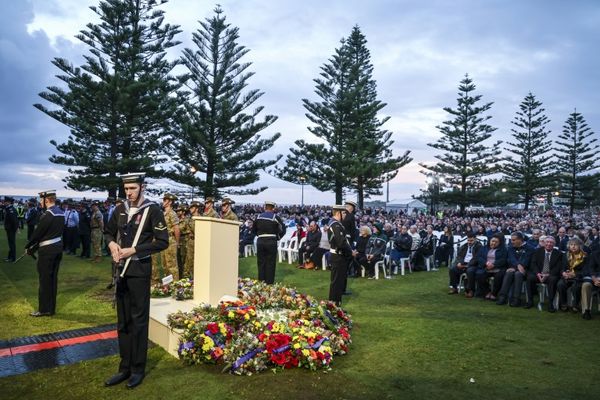
Artist Alison Aye had a surprising reaction to being accepted for this year’s Summer Exhibition at the Royal Academy. Founded in 1769, it’s the world’s oldest open submission show – a chance for hobbyist painters to hang next to Turner prize-winners and artists such as Tracey Emin and David Hockney, with everything for sale.
The 58-year-old textile and collage artist, who is based in London, has submitted work to the Royal Academy (RA) over the last 31 years, and always been rejected. But when, this year, she found out she had finally succeeded, she felt conflicted. “It’s the establishment acknowledging me and I don’t know if I like it,” she said. “There’s a part of me that thinks being on the losing side is all right.”
In being rejected, Aye was always in good company: John Constable, Edouard Manet and Banksy have had their work turned down. Aye has also been inspired by her rejection over the decades, creating the artwork RA Bastard Shites, 2018-2022 about the exhibition, which led to her appearance on comedian Joe Lycett’s documentary Summer Exhibitionist, about artists who submit to the show. Lycett successfully entered the work Chris in 2018, a bust of a man made from a Pringles tin, and, last year, the painting I drink a crisp, cold beer in a pool in Los Angeles while Gary Lineker looks on in disgust, which he priced at £1,354,999.
In the documentary, which aired on BBC Two in 2022, Lycett smuggled Aye’s unsuccessful submission that year into the RA on varnishing day, when artists ready their work for public viewing, and pinned it to the breakfast buffet table, an act that Aye found hilarious. “The buffet is so on-brand for me. Perfect.”
But when the show opens this week, she will be an official exhibitor, one of 482 showing there for the first time, out of the 16,500 submissions considered for 2024. There are 1,154 exhibitors in total in this year’s show.
Aye’s work for the exhibition, Shifting to the Moon, is quintessential of her style: subversive, political and personal. Shifting is slang from the north-east, where Aye grew up, for moving house. The work is made of hand-sewn images from newspapers and books to an old tea towel depicting some hapless members of the British royal family floating away on a hot air balloon fashioned from the moon in Georges Méliès’s film Le Voyage Dans La Lune.
Aye works constantly with paper and print for an ongoing art project which involves cutting a face from a news story or book each day and stitching it to fabric, to cataloguing world events from her perspective. She also keeps a meticulous record of where each image is from and who is depicted. “The faces pick me – they tend to be someone unknown who is part of a well-known story. Say, a picture of an unknown protester campaigning against shit in the ocean.”
The Summer Exhibition is always a cultural talking point. Though one Royal Academician organises the show each year – for 2024, it’s sculptor Ann Christopher – the submission of work by such a vast number of artists is meant to make the show feel representative of different creative viewpoints.
Aye is not so sure. It costs £40 to submit an artwork to be considered for the show, and that’s before you get it framed, she says. “Loads of people can’t afford that. I’m fine because I can get my Oyster card out to drop my work off. If you live in Glasgow, it’s not so easy.”
Aye works a number of day jobs and the only profit she has ever made from selling art was in 2022 when she netted £894. Before that, her best year was when she only made a loss of £375.92. Despite this, she donates to the charity Arts Emergency which helps young people find careers in the creative industries. She notes that the organisation recently posted on Instagram about the steep drop in working-class artists.
She grew up in Spennymoor, County Durham. Her mother worked as a cleaner and school-dinner lady and her dad as a miner. She left school at 16 – “no one mentioned sixth form, and most kids at my school didn’t even consider it” – but found out that she could study for a BTec at the Newcastle School of Art and Technology.
“It was an hour and 15 minutes on the bus each way, but turned my life around. I didn’t have culture shock when I moved to London, but I had it going from my town to Newcastle. It changed everything. It was a wonderful place.
“My dad was a pitman and he was on strike all the time I was there and the teachers knew I don’t know how because I was a little mouse at college, just staring and lapping it all up – but they did, and they gave me art materials. They were totally invested in the kids.”
Money is still a constraint. Aye started using textiles because she couldn’t afford paint but now loves working with fabric and thread. This year, she joined the 62 Group of Textile Artists, a co-operative originally founded in 1962 to support embroidery workers whose craft was dismissed as a hobby for ladies.
Does she have any advice for artists hoping to be picked for next year’s Summer Exhibition? “Don’t enter your work in the mixed media category. I’ve been unsuccessful every time doing that – I accidentally entered my piece as a sculpture this year and I think that’s why I got in.”
Aye is still considering what she will do next year. Is acceptance the end, or is it the beginning of a new phase of work? “I’m not sure yet. But I can’t imagine making art if there was no rejection. Wouldn’t that be boring?”







